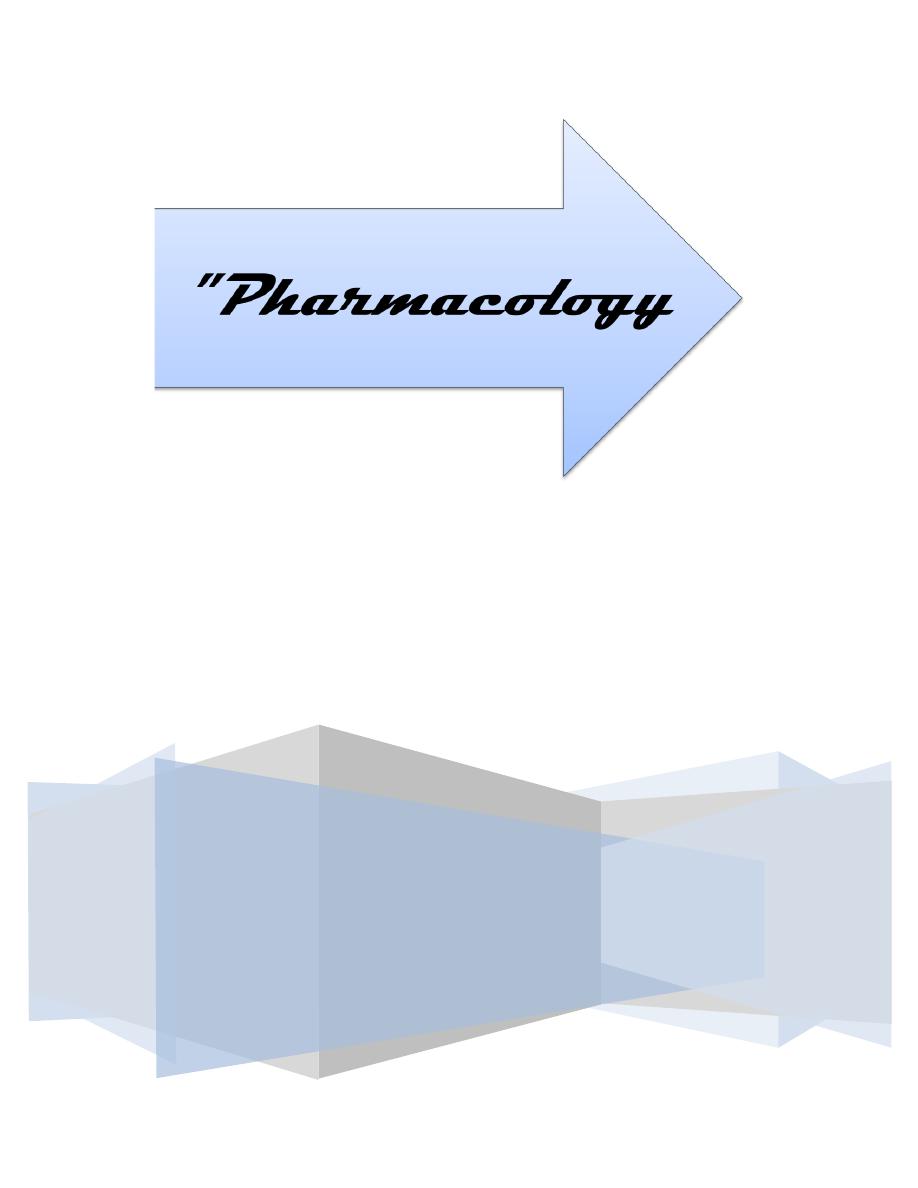
Sunday 19 / 10 / 2014
@Ali Kareem 2014-2015
Name
:
______________________________
Class
:
_______________________________
مكتب اشور لالستنساخ
CHOLINERGIC SYSTEM
Lecture 4
Total lectures NO. 6
Dr. Samer Matloub

22
Lec:4
Nicotinic antagonist:
A-Ganglionic blocking drugs:
These agents act specifically on nicotinic receptors by blocking the ion
channels in the ganglia both sympathetic and parasympathetic. Thus they
block the entire output of the ANS at the nicotinic receptors. They have no
effect on N-M junction .they were the 1
st
successful agents in the treatment of
hypertension. However because of their adverse effect, they are rarely used
nowadays. Examples of these drugs are hexamothanium, mecamylamine
and trimetaphan.
Nicotine
:
present in tobacco smoke and is used in the form of chewing
gum or transdermal patches by smokers to get rid of smoking and is still used
in some insecticides. Depending on the dose nicotine 1
st
stimulate the ganglia
which is followed by blockade. The stimulatory effects are complex which
include CNS stimulation Bp, HR (due to increase transmitter release from
adrenergic nerve terminals and adrenal medulla), peristalsis and secretion
and ADH release.
At higher doses Bp because of ganglionic blockade and the activity of
the smooth muscles and secretion is blocked.
B- Neuromuscular blocking drugs:
These neuromuscular blockers are structural analogues of Ach they are
either
Of:
1- A non- depolarizing type: (act as antagonists) e.g. tubocurarine.
2- A depolarizing type (act as agonists) e.g. succinylcholine.
N-M blockers are clinically useful during surgery to produce complete
muscle relaxation without the need to employ high anesthetic doses to
achieve a comparable muscle relaxation.
Non-depolarizing type (competitive N-M blockers):

23
(tubocurarine,
pancuronium,
gallamine,
rocuronium,
atracurium,
mivacurium, vecuronium, doxacurium).
All of these drugs are given parentraly. They differ in their onset and duration
of action (Rocuronium has the fastest onset of action), whether they are
metabolized by plasma choline esterase (e.g. mevacurrium) or eliminated in
bile (e.g.vecuronium) or by the kidney (e.g. doxacurium, pancuronium,
tubocurarine) or eliminated by an independent mechanism (e.g. atracurium)
which involves spontaneous breakdown called (hoffmann elimination).
Also these drugs differ in their autonomic effects and their ability to release
histamine e.g. tubocurarine blocks the ganglia and is the most likely of N-M
blockers to cause histamine release. Histamine release also occurs to a less
extent with atracurium and mivacurium , on the other hand pancuronium
and gallamine block the cardiac muscarinic receptors causing tachycardia.
Mechanism of action of non-depolarizing agents:
These drugs compete with Ach and produce a competitive block at the end
plate nicotinic receptors and thus prevent the depolarization of the muscle cell
membrane causing flaccid paralysis.
The action of these drugs can be overcome by the concentration of Ach at
the synaptic cleft e.g. by administration of ChE inhibitors (neostigmine or
edrophorium) some drugs in this group or when given in high doses may
directly act to plug (close) the ion channels of the end plate, this leads to
further weakening of N-M transmission and reduces the ability of ChE
inhibitors to reverse the action of these drugs.
small rapidly contracting muscles of the face and eye are the most
susceptible to blockage and are paralyzed first followed by the muscles of the
fingers then the limbs then neck and trunk muscles then the intercostals
muscles and lastly the diaphragm.
Therapeutic uses:
these drugs are used mainly as surgical adjuvant to
anesthesia for promoting skeletal muscle relaxation and for facilitating endo-
trachial intubation.

24
Adverse effects:
1- Respiratory paralysis if mechanical ventelation is not provided.
2- Autonomic effect and histamine release depending on the drugs used (e.g.
tubocurarine.)
Drug interactions:
Halogenated
hydrocarbon
anesthetics
(halothane,
Enflurane),
aminoglycoside antibiotics (e.g. gentamycin, tobramycin), calcium channel
blockers and some antiarrythmic drugs (e.g. quinidine) increase the effect of
N-M blockers. On the other hand ChE inhibitors antagonize their effect.
Depolarizing agents:
Succinylcholine (suxamethonium), decamethonium these depolarizing
agents act like Ach.on the nicotinic receptors of the motor end plate to
depolarize the junction.But unlike Ach, succinylcholine (because is not
rapidly hydrolyzed by ChE) remains attached to the receptor for a relatively
longer time providing a constant stimulation of the receptor.
Succinyl choline therefore first causes the opening of Na – channel associated
with nicotinic receptor which results in depolarization of the receptor (phase I)
this leads to a transient twitching of the muscle (fasciculation).
The continued binding of the depolarizing agent render the receptor incapable
of transmitting further impulses (desensitization) and results in flaccid
paralysis (phase II) in which the membrane repolarizes but the receptor is
desensitized to the effect of Ach.(a curare like effect). If a cholinesterase
inhibitor is given,
phase I is augmented but it may reverse phase II block.

25
Therapeutic uses:
Because of its rapid onset and short duration of action (only few minutes if
given as single dose) succinyl choline is useful for endotracheal intubation
during induction of anesthesia and may be also used during ECT (electro-
convulsive therapy).
Because of its brief duration of action (due to its rapid hydrolysis by plasma
ChE) it is usually given by a continuous infusion.
Adverse effects:
Malignant hyperthermia in genetically susceptible individual when
succinyl choline is used in combination with Halothane (anesthetic),
hyperpyrexia and muscle rigidity may occur, this is treated by rapidly
cooling the body and by administration of Dantrolene which blocks the
release of Ca from sarcoplasmic reticulum of the muscle cell thus reducing
heat and decreasing muscle rigidity which is associated with hyperpyrexia.
Apnea: a genetically related deficiency of plasma ChE or the presence of
atypical form of the enzyme can lead to prolonged apnea.
Other adverse effects include: post operative muscle pain, intragastric
pressure
which
may
promote
emesis
(vomiting),
IOP ,
hyperkalemia(especially in patients with burns).
Succinyl choline may cause stimulation of the autonomic ganglia and cardiac
muscarinic receptor (bradycardia) and has a slight ability to release histamine.
END
